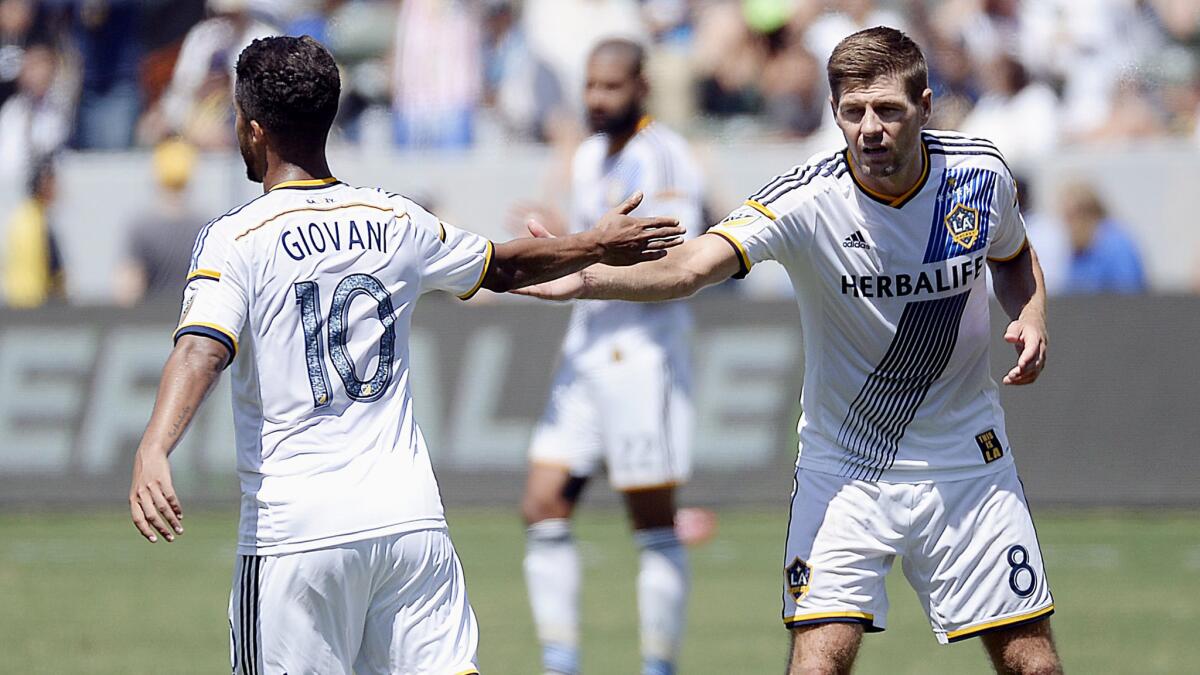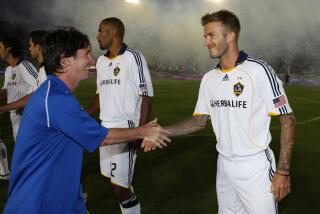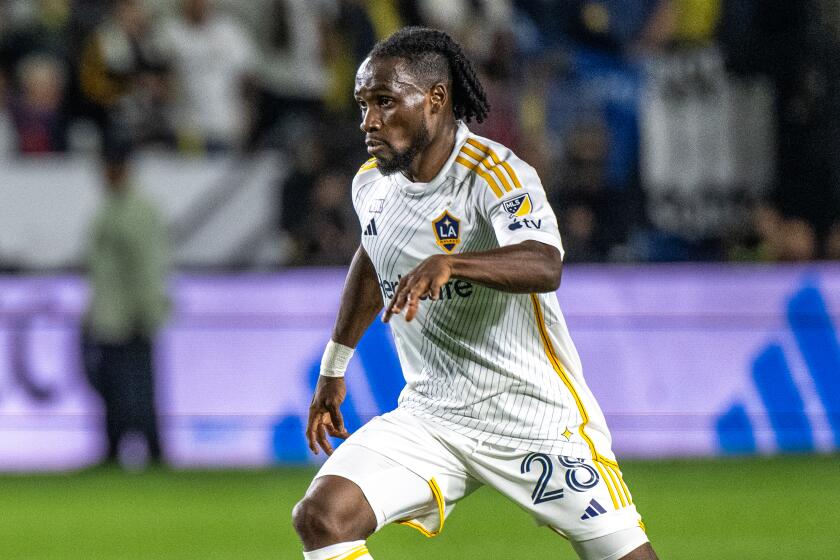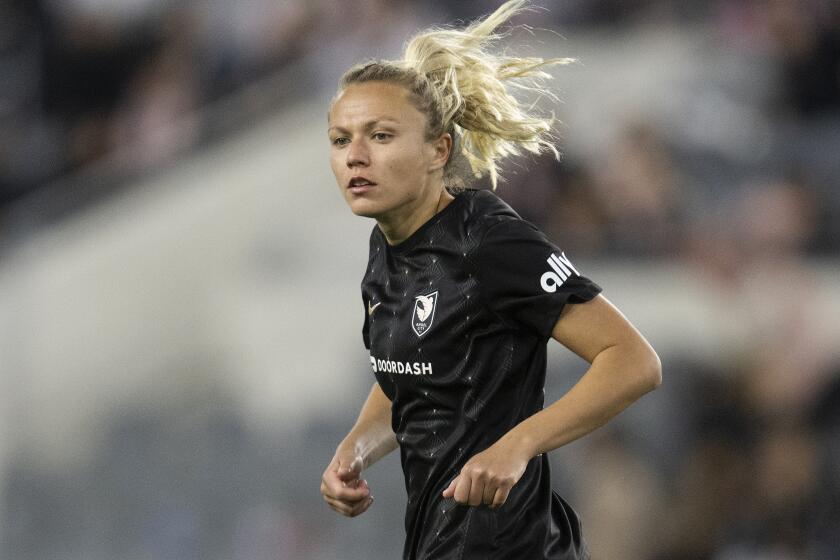MLS develops a buzz with international influx of talent

The Galaxy has been ahead of the MLS curve when it comes to bringing in international talent such as Giovani dos Santos from Mexico and Steven Gerrard from England.
Soccer may be the world’s game, but for much of Major League Soccer’s existence, the world only rarely penetrated the U.S. borders, leaving the country’s top league a primarily domestic one.
That isolationism is gone now, swept aside by a vigorous internationalism.
This season a majority of MLS players — 50.9% — were born outside the U.S. That has never happened before. And when the Galaxy meets New York City FC on Sunday at a sold-out StubHub Center, the two rosters will include 25 players that came to MLS from foreign leagues.
That’s also a league high — though Galaxy midfielder Steven Gerrard suspects that figure will not remain a record for long.
“There’s a buzz about the league,” said Gerrard, who left Liverpool for the Galaxy last month. “People want to be a part of that.”
Besides Gerrard, the former Liverpool captain, the Galaxy added Mexican national team star Giovani dos Santos this summer. Expansion team Orlando City debuted with Brazil’s Kaka, a former world player of the year, and New York City, also in its first season, has Chelsea legend Frank Lampard and two World Cup champions in David Villa (Spain) and Andrea Pirlo (Italy).
In January, Toronto FC signed national team forwards Sebastian Giovinco (Italy) and Jozy Altidore (U.S.). Montreal added Didier Drogba, an English Premier League legend and a two-time African player of the year, in July.
It’s arguably the most expansive influx of talent in the league’s 20-year history.
Those signings represent both a blessing and a curse for MLS, though. While the celebrity of players such as Gerrard, Lampard and Drogba has pushed the average attendance at MLS games to more than 20,000 — another league record — the three players are more than 109 years old combined. As a result, their additions, along with that of the aging Kaka and Pirlo, have furthered the league’s reputation as a retirement home for fading stars.
But that observation is a poor one, said Galaxy President Chris Klein.
“It’s simply not true,” he argues.
Gerrard, after all, led Liverpool in goals last season and last summer he captained an English World Cup team that included Lampard. And in addition to the aging English stars, MLS has also added twentysomethings Dos Santos, Giovinco and the oft-injured Altidore, who are all in their prime.
“The quality of our league is getting better,” Klein said. “We had players coming in at different ages, but now you’re seeing more. And more teams are spending. It’s not just the Galaxy.
“You have Toronto. You have New York. You have Orlando. You have other teams that are spending to bring big-name players in.”
That has put enormous pressure on the league and its single-entity business structure, under which teams are owned by the league and controlled by MLS investors. To prevent the runaway spending that bankrupted the North American Soccer League, those investors instituted a salary cap.
But paradoxically, to draw in the marquee names needed to grow the league, those same investors also approved ways to get around that cap.
First came the “Beckham Rule,” which allowed the Galaxy to acquire David Beckham in 2007. That provision was later expanded to allow teams to sign up to three “designated players,” whose salaries count only partially against the salary cap.
This year a record 47 of the league’s 60 DP spots are filled, with half the league’s teams at their three-player limit. So in July MLS gave each of the 20 teams another $500,000 in league money to spend on salaries over the next five years without having to count it against the cap.
Call that the “Dos Santos Rule” as it allowed the Galaxy to acquire the Mexican international in a $34-million deal, the richest in franchise history.
As a result of the creative bookkeeping, Toronto FC now has a payroll of more than $21.5 million, according to union figures, about $2.2 million more than the Galaxy’s. And though the two teams’ combined payrolls are still less than the Dodgers are spending on their infield, it’s awfully rich for a league with a salary cap of $3.49 million.
Todd Durbin, executive vice president for player relations and competition, said the league’s fiscal philosophies haven’t changed because each team is limited to the same number of DPs and the same salary cap. It’s just that some teams — like the Galaxy, which has 17 players earning $100,000 or more — use the rules better than others.
The development of domestic players was also among the league’s founding principles, and that too had been affected by the influx of players from overseas. But while the percentage of U.S.-born players in MLS has dropped dramatically in the last 12 years, from a high of 68.7% in 2004 to 49.1% this season, expansion has helped the overall number of domestic players in the league to grow to 247 this season, the second-highest total ever, according to the Elias Sports Bureau.
And the addition of so much foreign-born talent has helped raise the games of many of those domestic players as well.
“I know who I’m playing with. I know the standards I need to achieve,” said Sebastian Lleget, the Galaxy’s California-born midfielder. “So it definitely pushes my game up a level.
“I want that. I want to challenge myself and see how far I can go.”
MLS is also investing about $35 million a year on youth academies and other development programs aimed at domestic players, including an agreement with USL Pro under which the third-tier league now functions as a de facto minor league for MLS clubs.
If MLS has learned how to draw talent to the league, though, now it faces another problem: learning how to keep it.
Lleget, who left San Francisco for London’s West Ham United when he was a teenager, played only one competitive game in four years with the Hammers before returning to California and the Galaxy in May. And after scoring four times in his first five starts, leaving him second on the team in goals, he was quick to praise the league — just not to commit to it.
“I’ve learned what I had to learn and we’ll see down the road what lies ahead,” he said of a return to Europe. “I’d be open to it.”
Twitter: @kbaxter11







